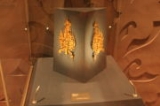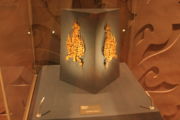
Muryeong of Baekje
Encyclopedia
Muryeong of Baekje was the 25th king of Baekje
, one of the Three Kingdoms of Korea
. During his reign, Baekje remained allied with Silla
against Goguryeo
, and expanded its relationships with China
and Japan
.
calls him King Sama (斯麻), and records his birth year as 462.
The Samguk Sagi
calls him King Muryeong, with the personal name (휘) of Sama (斯摩). He is described as the second son of the 24th king Dongseong
. He became king when Dongseong was assassinated by the court official Baekga. The following year, he crushed a planned rebellion by Baekga.
Japan's Nihonshoki gives his birth year as 461, and describes him as the son of Gonji, the younger brother of the 21st king Gaero
, making him the stepbrother of Dongseong. It is said Gonji escaped the invading Goguryeo forces with King Muryeong's mother to Japan, and she went into labor as their ship was passing by a small Japanese island. He was called Semakishi (嶋君) and King Shima (斯麻王) in Japanese records because he was born in an island.
Some scholars claim Muryeong ruled the Yamato
region under the name of King Bu before he moved to Baekje to be a king of kings(大王).
 In 501, he sent an army to attack Goguryeo's Sugok-seong. In 503, he repelled an attack by the Mohe. In 507, he successfully countered another attack by Goguryeo and Mohe forces. In 512, Goguryeo conquered two castles, but Muryeong personally led 3,000 men to destroy the Goguryeo army. In 523, he ordered the building of a fortified wall to defend the northern border.
In 501, he sent an army to attack Goguryeo's Sugok-seong. In 503, he repelled an attack by the Mohe. In 507, he successfully countered another attack by Goguryeo and Mohe forces. In 512, Goguryeo conquered two castles, but Muryeong personally led 3,000 men to destroy the Goguryeo army. In 523, he ordered the building of a fortified wall to defend the northern border.
According to both historical and archeological sources, contact and trade between China and Baekje increased during Muryeong's reign. In 512, according to the Liang shu, Muryeong sent Baekje's first mission to the newly-established court of the Chinese
Liang Dynasty
. A second mission was sent in 521, announcing various victories over Goguryeo
. In reply, the Liang emperor bestowed various titles on him, including "Great General Tranquilizing the East(寧東大將軍)" and "King of Baekje". These titles were also found engraved on a tablet in King Muryeong's tomb.
In 503, he sent a bronze mirror, and in 513 and 516, Confucian scholars to Japan.
was excavated in Songsan-ri, Gongju
, South Korea
, where he was buried with his queen.
In 2001, Japan's emperor Akihito
told reporters "I, on my part, feel a certain kinship with Korea, given the fact that it is recorded in the Chronicles of Japan that the mother of Emperor Kammu was of the line of King Muryong of Baekje." It was the first time that a Japanese emperor publicly acknowledged Korean blood in the imperial line. According to the Shoku Nihongi
, Emperor Kammu
's mother, Takano no Niigasa
is a descendant of Prince Junda, son of Muryeong, who died in Japan in 513 (Nihon Shoki
Chapter 17).
Baekje
Baekje or Paekche was a kingdom located in southwest Korea. It was one of the Three Kingdoms of Korea, together with Goguryeo and Silla....
, one of the Three Kingdoms of Korea
Three Kingdoms of Korea
The Three Kingdoms of Korea refer to the ancient Korean kingdoms of Goguryeo, Baekje and Silla, which dominated the Korean peninsula and parts of Manchuria for much of the 1st millennium...
. During his reign, Baekje remained allied with Silla
Silla
Silla was one of the Three Kingdoms of Korea, and one of the longest sustained dynasties in...
against Goguryeo
Goguryeo
Goguryeo or Koguryŏ was an ancient Korean kingdom located in present day northern and central parts of the Korean Peninsula, southern Manchuria, and southern Russian Maritime province....
, and expanded its relationships with China
China
Chinese civilization may refer to:* China for more general discussion of the country.* Chinese culture* Greater China, the transnational community of ethnic Chinese.* History of China* Sinosphere, the area historically affected by Chinese culture...
and Japan
Japan
Japan is an island nation in East Asia. Located in the Pacific Ocean, it lies to the east of the Sea of Japan, China, North Korea, South Korea and Russia, stretching from the Sea of Okhotsk in the north to the East China Sea and Taiwan in the south...
.
Background
The Tomb of King MuryeongTomb of King Muryeong
The Tomb of King Muryeong, also known as Songsan-ri Tomb No. 7, is the ancient tumulus of King Muryeong, who ruled the Baekje Kingdom from 501 to 523, and his queen...
calls him King Sama (斯麻), and records his birth year as 462.
The Samguk Sagi
Samguk Sagi
Samguk Sagi is a historical record of the Three Kingdoms of Korea: Goguryeo, Baekje and Silla. The Samguk Sagi is written in Classical Chinese and its compilation was ordered by Goryeo's King Injong Samguk Sagi (History of the Three Kingdoms) is a historical record of the Three Kingdoms of...
calls him King Muryeong, with the personal name (휘) of Sama (斯摩). He is described as the second son of the 24th king Dongseong
Dongseong of Baekje
Dongseong of Baekje was the 24th king of Baekje, one of the Three Kingdoms of Korea.-Background:He was the son of Gonji, the younger brother of the 22nd king Munju who returned to Baekje from Yamato Japan in 477 after hearing of the fall of the Baekje capital. Gonji died in that year, and like...
. He became king when Dongseong was assassinated by the court official Baekga. The following year, he crushed a planned rebellion by Baekga.
Other records
China's Liang shu gives his surname as Yeo and personal name as Yung, and states that he restored Baekje into a strong nation.Japan's Nihonshoki gives his birth year as 461, and describes him as the son of Gonji, the younger brother of the 21st king Gaero
Gaero of Baekje
Gaero of Baekje was the 21st king of Baekje, one of the Three Kingdoms of Korea. He was the eldest son of the 20th king Biyu...
, making him the stepbrother of Dongseong. It is said Gonji escaped the invading Goguryeo forces with King Muryeong's mother to Japan, and she went into labor as their ship was passing by a small Japanese island. He was called Semakishi (嶋君) and King Shima (斯麻王) in Japanese records because he was born in an island.
Some scholars claim Muryeong ruled the Yamato
Yamato
Yamato was originally the area around today's Sakurai City in Nara Prefecture of Japan. Later the term was used as the name of the province and also as an ancient name of Japan...
region under the name of King Bu before he moved to Baekje to be a king of kings(大王).
Reign

According to both historical and archeological sources, contact and trade between China and Baekje increased during Muryeong's reign. In 512, according to the Liang shu, Muryeong sent Baekje's first mission to the newly-established court of the Chinese
China
Chinese civilization may refer to:* China for more general discussion of the country.* Chinese culture* Greater China, the transnational community of ethnic Chinese.* History of China* Sinosphere, the area historically affected by Chinese culture...
Liang Dynasty
Liang Dynasty
The Liang Dynasty , also known as the Southern Liang Dynasty , was the third of the Southern dynasties in China and was followed by the Chen Dynasty...
. A second mission was sent in 521, announcing various victories over Goguryeo
Goguryeo
Goguryeo or Koguryŏ was an ancient Korean kingdom located in present day northern and central parts of the Korean Peninsula, southern Manchuria, and southern Russian Maritime province....
. In reply, the Liang emperor bestowed various titles on him, including "Great General Tranquilizing the East(寧東大將軍)" and "King of Baekje". These titles were also found engraved on a tablet in King Muryeong's tomb.
In 503, he sent a bronze mirror, and in 513 and 516, Confucian scholars to Japan.
Legacy
In 1971, King Muryeong's tombTomb of King Muryeong
The Tomb of King Muryeong, also known as Songsan-ri Tomb No. 7, is the ancient tumulus of King Muryeong, who ruled the Baekje Kingdom from 501 to 523, and his queen...
was excavated in Songsan-ri, Gongju
Gongju
Gongju , also spelt Kongju, is a city in South Chungcheong province, South Korea. It is located at .- History :Gongju was formerly named Ungjin and was the capital of Baekje from AD 475 to 538. In this period, Baekje was under threat from Goguryeo...
, South Korea
South Korea
The Republic of Korea , , is a sovereign state in East Asia, located on the southern portion of the Korean Peninsula. It is neighbored by the People's Republic of China to the west, Japan to the east, North Korea to the north, and the East China Sea and Republic of China to the south...
, where he was buried with his queen.
In 2001, Japan's emperor Akihito
Akihito
is the current , the 125th emperor of his line according to Japan's traditional order of succession. He acceded to the throne in 1989.-Name:In Japan, the emperor is never referred to by his given name, but rather is referred to as "His Imperial Majesty the Emperor" which may be shortened to . In...
told reporters "I, on my part, feel a certain kinship with Korea, given the fact that it is recorded in the Chronicles of Japan that the mother of Emperor Kammu was of the line of King Muryong of Baekje." It was the first time that a Japanese emperor publicly acknowledged Korean blood in the imperial line. According to the Shoku Nihongi
Shoku Nihongi
The is an imperially commissioned Japanese history text. Completed in 797, it is the second of the Six National Histories, coming directly after the Nihon Shoki and followed by Nihon Kōki. Fujiwara no Tsugutada and Sugano no Mamichi served as the primary editors...
, Emperor Kammu
Emperor Kammu
was the 50th emperor of Japan, according to the traditional order of succession. Kammu reigned from 781 to 806.-Traditional narrative:Kammu's personal name was . He was the eldest son of Prince Shirakabe , and was born prior to Shirakabe's ascension to the throne...
's mother, Takano no Niigasa
Takano no Niigasa
Takano no Niigasa was a concubine of Emperor Kōnin and the mother of Emperor Kammu. Her full name was Takano no Asomi Niigasa.-Life:...
is a descendant of Prince Junda, son of Muryeong, who died in Japan in 513 (Nihon Shoki
Nihon Shoki
The , sometimes translated as The Chronicles of Japan, is the second oldest book of classical Japanese history. It is more elaborate and detailed than the Kojiki, the oldest, and has proven to be an important tool for historians and archaeologists as it includes the most complete extant historical...
Chapter 17).
Further Reading
- Kim, Won-Yong. “The Tomb of King Muryong of the Paekche Dynasty.” Asian Pacific Quarterly of Cultural and Social Affairs (Seoul) 3:3 (Winter 1971): 34-46.
- Paik, Seung-gil. "Excavation of the Tomb of Paekche King Muryong." Korea Journal 11:8 (August 1971): 48-51.

